英文版中国美食介绍37页PPT
- 格式:ppt
- 大小:3.99 MB
- 文档页数:37

![舌尖上的中国[英文版]中国美食介绍](https://uimg.taocdn.com/115ea252336c1eb91a375d38.webp)
![舌尖上的中国[英文版]中国美食介绍 PPT课件](https://uimg.taocdn.com/ab5110afdd88d0d233d46af0.webp)
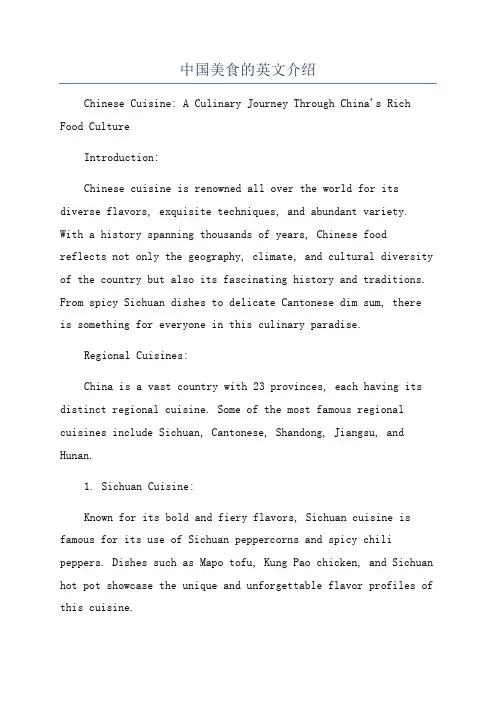
中国美食的英文介绍Chinese Cuisine: A Culinary Journey Through China's Rich Food CultureIntroduction:Chinese cuisine is renowned all over the world for its diverse flavors, exquisite techniques, and abundant variety. With a history spanning thousands of years, Chinese foodreflects not only the geography, climate, and cultural diversity of the country but also its fascinating history and traditions. From spicy Sichuan dishes to delicate Cantonese dim sum, there is something for everyone in this culinary paradise.Regional Cuisines:China is a vast country with 23 provinces, each having its distinct regional cuisine. Some of the most famous regional cuisines include Sichuan, Cantonese, Shandong, Jiangsu, and Hunan.1. Sichuan Cuisine:Known for its bold and fiery flavors, Sichuan cuisine is famous for its use of Sichuan peppercorns and spicy chili peppers. Dishes such as Mapo tofu, Kung Pao chicken, and Sichuan hot pot showcase the unique and unforgettable flavor profiles of this cuisine.2. Cantonese Cuisine:Cantonese cuisine, originating from Guangdong province, focuses on preserving the natural flavor of the ingredients. Dim sum is a popular Cantonese specialty, consisting of bite-sized portions of food such as dumplings, buns, and rice rolls. Other famous dishes include roasted meats, sweet and sour dishes, and seafood delicacies.3. Shandong Cuisine:As one of the oldest regional cuisines, Shandong cuisine is known for its emphasis on seafood and starchy dishes. Clear and hearty broths, delicate seafood dishes, and home-style cooking techniques characterize this cuisine. Famous dishes include braised abalone, steamed sea bass, and the iconic Shandong-style sweet and sour carp.4. Jiangsu Cuisine:5. Hunan Cuisine:Hunan cuisine, also known as Xiang cuisine, is famous forits spicy and flavorsome dishes. It incorporates a wide range of ingredients, including pickled vegetables, chili peppers, and smoked meats. Notable dishes include Chairman Mao's favorite, the Braised pork belly, and spicy stir-fried Hunan beef.Key Flavors and Techniques:1. Stir-Frying:2. Dim Sum:Dim sum, meaning "to touch the heart," refers to a variety of bite-sized dishes that are traditionally served in bamboo steamers. These small but flavorful dishes include dumplings, buns, spring rolls, and rice noodle rolls. Dim sum is often enjoyed with tea and is a favorite among locals and tourists alike.3. Sweet and Sour:4. Dumplings and Baozi:5. Hot Pot:Conclusion:Chinese cuisine is a treasure trove of flavors, techniques, and regional specialties. It is a harmonious blend of tradition, innovation, and diversity that captivates the food lovers worldwide. From fiery Sichuan dishes to delicate Cantonese dim sum, exploring the rich food culture of China is like embarking on a culinary adventure that celebrates the country's history, traditions, and the art of gastronomy. Whether you're a fan of spicy, sweet, or savory, Chinese cuisine has something extraordinary to satisfy every palate.。
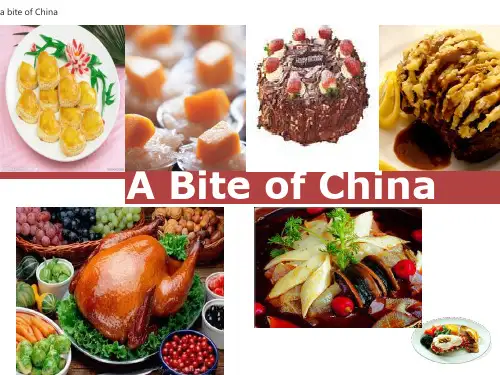
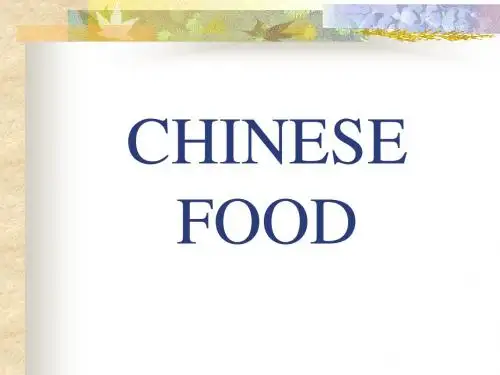
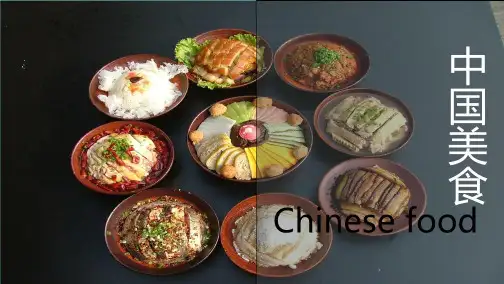
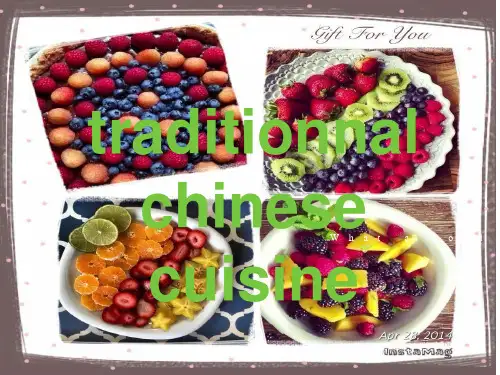
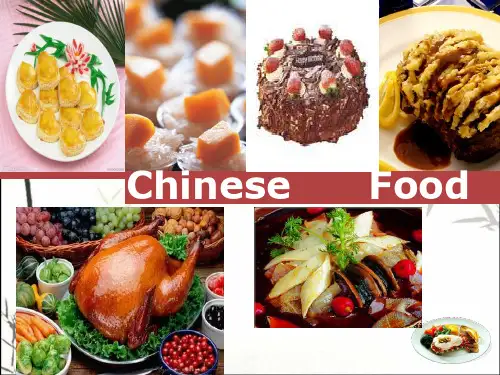
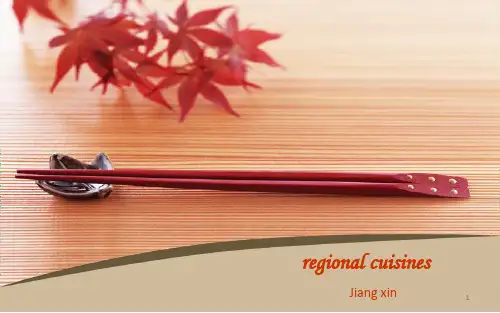
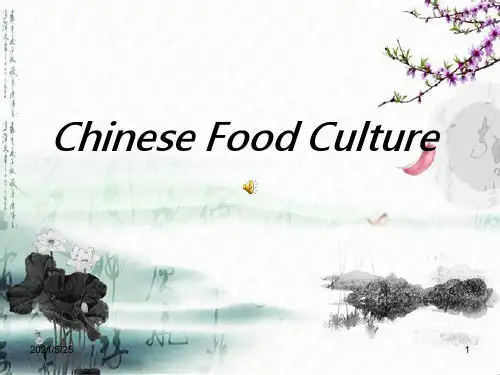
中国美食的英文介绍Introduction to Chinese CuisineChinese cuisine is known all over the world for its rich flavors, diverse culinary techniques, and exquisite presentation. With a history of thousands of years, traditional Chinese dishes reflect the country's vast geography, varied climate, anddiverse cultural heritage. From aromatic street food toelaborate banquet dishes, Chinese cuisine offers a wide range of flavors and textures that are sure to tantalize the taste budsof any food lover.Regional CuisineChina is a vast country with diverse regional culinary traditions. Each region has its own unique ingredients, cooking methods, and flavor profiles. Here are some of the most famous regional cuisines in China:1. Cantonese Cuisine: Originating from Guangdong province, Cantonese cuisine is known for its delicate flavors and fresh ingredients. Dim sum, roasted meats, and seafood dishes are popular in Cantonese cuisine.3. Shandong Cuisine: Shandong cuisine is known for its emphasis on seafood and strong flavors. Popular dishes include braised abalone, sweet and sour carp, and yellow river carp in sweet and sour sauce.4. Jiangsu Cuisine: Jiangsu cuisine, also known as Huaiyang cuisine, focuses on fresh and delicate flavors. It utilizes ingredients such as freshwater fish, crabs, and duck. The most famous dish from this cuisine is the delicately seasoned Crystal Shrimp.5. Hunan Cuisine: From the Hunan province in central China, Hunan cuisine is known for its spicy and flavorful dishes. It offers a wide variety of flavors, including sour, spicy, sweet, and salty. Popular dishes include Dong'an chicken and Chairman Mao's Red Braised Pork.Famous Chinese DishesChinese cuisine boasts a wide array of famous and beloved dishes that have gained popularity worldwide. Here are some iconic Chinese dishes:1. Peking Duck: This dish originated from Beijing and features crispy, roasted duck with a thin, crispy skin served with pancakes, spring onions, hoisin sauce, and cucumber slices.2. Kung Pao Chicken: A popular Sichuan dish, Kung Pao chicken is a stir-fried dish made with diced chicken, peanuts, vegetables, and chili peppers. It is known for its spicy and tangy flavor.3. Mapo Tofu: One of the most famous dishes from Sichuan cuisine, Mapo tofu is a spicy and flavorful dish made with tofu, minced meat, fermented beans, chili oil, and Sichuan peppercorns.5. Dim Sum: Dim sum refers to a variety of bite-sized food items such as dumplings, buns, and rolls that are steamed or fried. Dim sum is traditionally served in bamboo steamers and is a popular choice for brunch or yum cha.ConclusionChinese cuisine is a treasure trove of flavors and textures, reflecting the country's rich culinary traditions and cultural diversity. From spicy Sichuan dishes to delicate Cantonese dim sum, there is something for everyone to enjoy in Chinese cuisine. Whether you explore the regional specialties or indulge iniconic dishes like Peking Duck, Chinese cuisine promises an unforgettable culinary experience for any food enthusiast.。
Chinese traditional cuisine, renowned for its rich flavors, diverse textures, and exquisite presentation, is a culinary heritage that has been celebrated for thousands of years. The fusion of regional ingredients, traditional cooking techniques, and a deep-rooted cultural philosophy creates a tapestry of dishes that reflect the diversity of China's vast landscape and the complexity of its history. In this exploration of Chinese traditional cuisine, we delve into some iconic dishes, cooking methods, and cultural significance that contribute to the uniqueness of this culinary tradition.### **Iconic Dishes:**#### 1. **Peking Duck (北京烤鸭):**Peking Duck is a globally recognized symbol of Chinese cuisine. Originating from Beijing, this dish involves a meticulous process of preparing and roasting a whole duck until its skin turns crispy and golden. The succulent duck slices are usually served with thin pancakes, hoisin sauce, and sliced scallions, creating a delightful combination of flavors and textures.#### 2. **Dim Sum (点心):**Dim Sum, a style of Chinese cuisine originating from the Cantonese region, consists of a variety of bite-sized dishes typically served in small steamer baskets or on small plates. Dumplings, buns, spring rolls, and other delicacies make up a dim sum spread. This communal dining experience is popular for its wide array of flavors, textures, and ingredients.#### 3. **Hot Pot (火锅):**Hot Pot is a communal and interactive dining experience that involves cooking raw ingredients like thinly sliced meat, vegetables, and noodles in a simmering pot of flavored broth at the dining table. The variety of broths and dipping sauces contribute to the rich and customizable nature of this dish, making it a favorite during cold seasons.#### 4. **Kung Pao Chicken (宫保鸡丁):**Kung Pao Chicken is a classic Sichuan dish known for its bold flavors. It typically features diced chicken stir-fried with peanuts, vegetables, and chili peppers. The dish is named after Ding Baozhen, a late Qing dynasty official with the title Kung Pao, who was known for his love of spicy food.#### 5. **Mapo Tofu (麻婆豆腐):**Hailing from Sichuan province, Mapo Tofu is a spicy and numbing dish that showcases the distinctive flavors of Sichuan cuisine. It consists of soft tofu cubes cooked in a spicy chili and bean-based sauce, often complemented by minced meat, garlic, and green onions.### **Cooking Methods:**#### 1. **Stir-Frying (炒):**Stir-frying is a fundamental cooking technique in Chinese cuisine. It involves quickly cooking small, bite-sized ingredients over high heat in a wok. The rapid cooking process preserves the naturalflavors, textures, and colors of the ingredients, resulting in dishes that are both flavorful and nutritious.#### 2. **Steaming (蒸):**Steaming is a healthy and delicate cooking method widely used in Chinese cuisine. Dim Sum, for example, often involves steaming dumplings and buns to retain moisture and showcase the natural flavors of the ingredients.#### 3. **Braising (炖):**Braising is a slow-cooking method where ingredients are first browned in a wok and then simmered in a flavorful liquid. This technique allows the ingredients to absorb the rich flavors of the braising liquid, resulting in tender and aromatic dishes.#### 4. **Red Cooking (红烧):**Red cooking is a method where ingredients are braised or stewed in a soy sauce-based liquid, giving the dish a rich, reddish-brown color. It's commonly used for meats, tofu, and eggs, creating dishes with a savory and slightly sweet flavor.### **Cultural Significance:**#### 1. **Harmony in Ingredients:**Chinese traditional cuisine places a strong emphasis on achieving harmony in flavors, colors, aromas, and textures. The balance of sweet and sour, salty and umami, crunchy and tender reflects the Taoist philosophy of Yin and Yang, creating a holistic dining experience.#### 2. **Festivals and Symbolism:**Many traditional Chinese dishes hold symbolic meanings, especially during festivals and celebrations. For example, dumplings are often eaten during the Chinese New Year as they symbolize wealth and prosperity due to their resemblance to ancient Chinese gold or silver ingots.#### 3. **Family Bonding:**Food plays a central role in Chinese family life, fostering a sense of togetherness and bonding. Shared meals, particularly during holidays, are viewed as an expression of love and unity among family members.#### 4. **Medicinal Properties:**Traditional Chinese medicine principles are integrated into cooking practices, with certain ingredients believed to have medicinal properties. Foods like ginger, garlic, and various herbs are incorporated into dishes for both flavor and potential health benefits.### **Conclusion:**Chinese traditional cuisine is a rich tapestry that weaves together history, culture, and culinaryartistry. From the iconic Peking Duck to the nuanced flavors of Mapo Tofu, each dish tells a story of regional diversity and cultural heritage. The cooking techniques reflect a deep understanding of the relationship between ingredients and the importance of achieving balance in every aspect of the dining experience. As China continues to evolve, its traditional cuisine remains a timeless celebration of flavors and a source of pride for people worldwide.。